 |
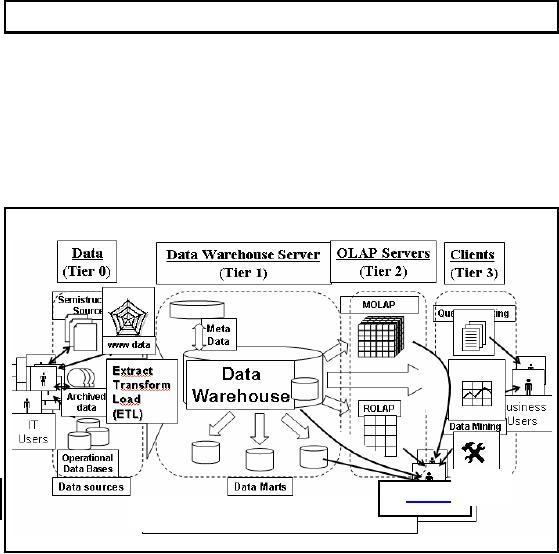
Lecture-16
Extract
Transform Load (ETL)
In a DWH
project, 50% of the work is
related to ETL. ETL stands
for Extract Transform
Load.
Some people
call it ETML i.e. Extract
Transform Move Load, as you
have to move the data
into
the
DWH. There is a significant part after
data transformation that involves
data cleansing i.e.
there is a C
also here. However, ETL is a
pretty standard definition, and
normally when you say
ETL
people know what you
mean.
E: Extract
from the operational
system
T: Transform
the data, which includes
data cleansing
L: Loading
the data into the
DWH
Putting
the pieces
together
Tools
Business
Users
Figure-16.1:
ETL: Putting the pieces
together
Figure -16.1
shows a multi-tiered data warehousing
architecture. We can see
that at the lowest
level
(tier 0) lies the data
sources like operational, archived
and/or web etc. Data
Warehouse
Server lays in
the next level (tier 1). We
can see in the Figure 16.1
that ETL box lies at
the
boundaries of
both the tiers 0 and 1. That
means it serves as a bridgebetween data
source systems
and
the actual data warehouse.
Thus the source data is
processed using some set of
activities
before
bringing it into the data
warehouse environment. These
set of activities comprise the
ETL
process.
117
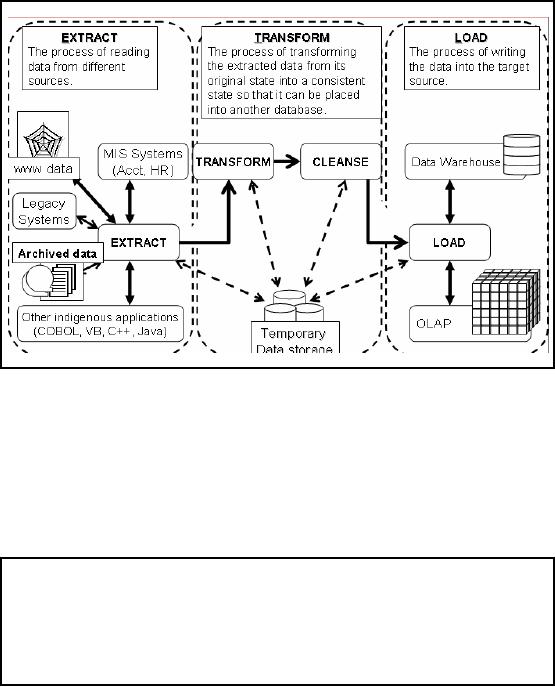
The
ETL Cycle
Figure-16.2:
The ETL Cycle
Now what
are those activities in the
ETL process shown as a box in
the Figure 16.1? Let's have
a
look
inside the box to find the
sequence of activities that constitute
the ETL process. As shown
in
Figure
16.2 ET L process consists of
three major activities
separated by dotted lines.
The first
step is
the Extract
which is
the activity of reading data
from multiple heterogeneous
data sources.
Next comes
the Transform
step
which is the activity of
transforming the input data
from multiple
heterogeneous
environments into a single consistent
state. Another important activity at
this level
is the
data
cleansing which is
the activity of noise
removal from input data before
bringing it in
the
DWH environment. The final
step is the Load
which is an
activity of loading cleansed data
in
to the
target system.
ETL
Processing
ETL is
independent yet interrelated
steps.
It is important to
look at the big
picture.
Data
acquisition time may
include...
118
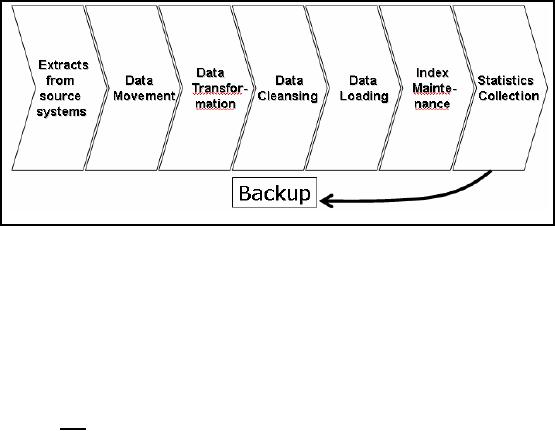
Back-up is a major
task, its a DWH not a
cube
Figure-16.3:
ETL Processing
When we
look at ETL processing, it is important
to look at the big picture as
shown in Figure
16.3. It is not
just the transformation; there is a
whole lot of work you have
to consider in the
design
and architecture of the ETL
model. You have to design to
extract from source system,
how
to get
the data out of the operational
databases. You have to move
the data to the dedicated
server
where the
transformations are being done or on the
very least if the
transformations will be
done
on the
same systems, start moving
the data into the
warehouse environment. You
have to look at
the
data movement and all the
network implications of data movement.
The transformations we
will be
talking about and the
data loading strategies all
have to be considered. It is not just
good
enough to talk
about data loading, we have to do index
maintenance, statistics
collection,
summary,
data maintenance, data mart
construction, data back ups,
a whole process has to
be
followed
each time you refresh or reload
the data warehouse.
The
architects really need to
consider all of these. We
will be focusing on all the
major operations
of ETL, so as to
understand the big picture. It is
certainly true that the volume of
the data
warehouse
will make a difference on
how you do the backups and
the technology. Consider
a
cube
which is not a data
warehouse, it is a data mart.
Typically a data mart is
much smaller and
probably pretty
easier to backup just part
of a file system backu p on
wherever your cube server
is.
The
data warehouse is usually
much bigger. So for a data
warehouse you usually do a full
tape
backup,
and a tape -backup would
ideally use a robotic tape
library and all the
associated setup.
Typically you
don't need robotic libraries for
the cubes and data
marts, but you do need them
for
data
warehouse. But again you have to
come back to economics, robotic
tape libraries are
very
expensive,
and so you may actually use
manual tape mounting, because it is
not worth paying fo r
robots when you
can have humans do it on a very
different price range.
119

Overview of
Data Extraction
First
step of ETL, followed by
many.
Source
systems for extraction are
typically OLTP systems.
A very
complex task due to number of
reasons:
� Very
complex and poorly
documented source
system.
� Data
has to be extracted not once, but number
of times.
The
process design is dependent
on:
� Which
extraction method to
choose?
� How to
make available extracted
data for further
processing?
Extraction is
the operation of extracting data from a
source system for further
use in a data
warehouse
environment. This is the
first step of the ETL
process. After the
extraction, this data
can be
transformed, cleansed and loaded
into the data
warehouse.
The
source systems for a data
warehouse are typically transaction
processing applications.
For
example,
one of the source systems
for a sales analysis data
warehouse might be an order
entry
system
that records all of the
current order activities.
Designing
and creating the extraction process is
often one of the most time
-consuming tasks in
the
ETL process and, indeed, in
the entire data warehousing process.
The source systems
might
be very complex
and poorly documented, and
thus determining which data
needs to be extracted
can be
difficult. The data has to
be extracted normally not only
once, but several times in a
periodic
manner to supply all changed
data to the warehouse and
keep it up-to-date.
Moreover,
the
source system typically
cannot be modified, nor c n
its performance or availability
be
a
adjusted, to
accommodate the needs of the
data warehouse extraction
process. These are
important
considerations for extraction
and ETL in general.
Designing this
process means making decisions
about the following two main
aspects:
� Which
extraction method to
choose?
This influences
the source system and
the time needed for refreshing
the warehouse.
� How to
make available extracted
data for further
processing?
This influences
the transportation method,
and the need for
cleaning and transforming the
data.
Types of
Data Extraction
�
Logical
Extraction
� Full
Extraction
� Incremental
Extraction
�
Physical
Extraction
� Online
Extraction
� Offline
Extraction
� Legacy vs.
OLTP
There
are different types of data
extraction which can be broadly
categorized into two
data
extraction
techniques, logical and
physical. The extraction method you
should choose is
highly
dependent on
the source system and
also on the business needs
in the target data
warehouse
120

environment.
Very often, the re's no
possibility to add additional logic to
the source systems to
enhance an
incremental extraction of data due to
the performance or the increased
workload of
these
systems. Sometimes even the
customer is not allowed to add anything
to an out -of-the-box
(shrink wrapped CD
installable) application system as the
performance of the source
system has
been
maximized and carefully
calibrated and monitored. The
reason being creation of the
DWH
does not
directly help the operational people in
any way, for them asking
for data every now
and
then is an
annoyance.
The
estimated amount of the data
to be extracted and the
stage in the ETL process
(initial load or
maintenance of
data i.e. data already
loaded) may also effect the
decision of how to extract,
from
a logical
and a physical perspective.
Basically, you have to decide
how to extract data
logically
and
physically. Let's discuss
logical techniques first in
detail.
Logical
Data Extraction
�
Full
Extraction
� The
data extracted completely from
the source system.
�
No need to
keep track of
changes.
�
Source
data made available as -is
w/o any additional
information.
�
Incremental
Extraction
� Data
extracted after a well defined point/event in
time.
�
Mechanism
used to reflect/record the temporal
changes in data (column
or
table).
�
Sometimes entire
tables off-loaded from
source system into the
DWH.
�
Can have
significant performance impacts on the
data warehouse
server.
The
two logical data extraction
types are full and
incremental extraction
techniques.
Let's
look at the two in
detail.
Full
Extraction
The
data is extracted completely from
the source system. Since
this extraction reflects all
the data
currently
available in the source
system, there's no need to
keep track of changes to the
data
source since the
ast successful extraction.
The source data will be
provided as -is and no
l
additional
logical information (for
example, timestamps etc) is
necessary on the source
site. An
example
for a full extraction may be an export
file of a distinct table or a remote SQ L
statement
scanning
the complete source
table.
Incremental
Extraction
At a specific
point in time, only the
data that has changed
since a well -defined event back
in
history will be
extracted. This event may be
the last time of extraction or a more
comple x
business event
like the last day of
balancing of accounts. To identify this
incremental change
there
must be a mechanism to identify
all the changed information
since this specific time event.
This
information can be either provided by
the source data it self like
an application column,
reflecting
the last-changed timestamp or a
change table where an appropriate
additional
121

mechanism
keeps track of the changes
besides the originating
transactions. In most cases,
using
the
latter method means adding
extraction logic to the
source system.
Many
data warehouses do not use
any change -capture
techniques as part of the
extraction
process.
Instead, entire tables from
the source systems are
extracted to the data
warehouse or
staging
area, and these tables
are compared with a previous
extract from the source
system to
identify
the changed data. This
approach may not have
significant impact on the
source systems,
but it can
clearly place considerable burden on the
data warehouse processes,
particularly if the
data
volu mes are
large.
Physical
Data Extraction...
�
Online
Extraction
� Data
extracted directly from the
source system.
� May
access source tables through an
intermediate system.
� Intermediate
system usually similar to
the source system.
�
Offline
Extraction
� Data
NOT extracted directly from
the source system, instead
staged explicitly
outside
the original source
system.
� Data is
either already structured or
was created by an extraction
routine.
� Some of
the prevalent structures
are:
� Flat
files
� Dump
files
� Redo and
archive logs
� Transportable
table-spaces
Physical
Extraction Methods
Depending on the
chosen logical extraction
method and the capabilities
and restrictions on
the
source
side, the extracted data
can be physically extracted by two
mechanisms. The data
can
either be
extracted online from the
source system or from an
offline structure. Such an
offline
structure might
already exist or it might be generated by
an extraction routine.
Online
Extraction
The
data is extracted directly
from the source system
itself. The extraction process
can connect
directly to
the source system to access
the source tables themselves
or to an intermediate system
that
stores the data in a preconfigured
manner (for example,
snapshot logs or change
tables). Note
that
the intermediate system is not
necessarily physically different from
the source system.
With
online
extractions, you need to consider whether
the distributed transactions are
using original
source
objects or prepared source
objects.
Offline
Extraction
The
data is not extracted
directly from the source
system but is staged explicitly
outside the
original
source system. The data
already has an existing
structure (for example, redo
logs, archive
logs or
transportable table-spaces) or was
created by an extraction routin
e.
You should
consider the following
structures:
� Flat
files
�
Data in a
defined, generic format. Dump
files
� DBMS-specific format.
Redo and archive logs
� Transportable
table-spaces
122

Physical
Data Extraction
�
Legacy
vs. OLTP
�
Data
moved from the source
system
�
Copy
made of the source system
data
�
Staging
area used for performance
reasons
During
extraction, data may be
removed from the source
system or a copy made and
the original
data
retained in the source
system. It is common to move historical
data that accumulates in
an
operational OLTP
system to a data warehouse to maintain
OLTP performance and
efficiency.
Legacy
systems may require too much
effort to implement such offload
processes, so legacy
data
is often copied
into the data warehouse,
leaving the original data in
place. Extracted data is
loaded
into
the data warehouse staging
area (a relational database usually
separate from the
data
warehouse
database), for manipulation by the
remaining ETL processes. Data
extraction
processes
can be implemented using SQL
stored procedures, Vendor tools, or
custom applications
developed in programming or
scripting languages.
Data
Transformation
�
Basic
tasks
�
Selection
�
Splitting/Joining
�
Conversion
�
Summarization
� Enrichment
The
next operation in the ETL
process is the Data
Transformation. The major
tasks performed
during
this phase vary depending on
the application; however the
basic tasks are discussed
here.
Selection:
This
takes place at the beginning of
the whole process of data
transformation. You
select
either whole records or
parts of several records
from the source systems.
The task of
selection
usually forms part of the
extraction function itself. However, in
some cases, the
composition of
the source structure may not
be supporting selection of the necessary
parts during
data
extraction. In these cases, it is advised
to extract the whole record
and then do the
selection
as part of
the transformation function.
Splitting/joining:
This
task includes the types of
data manipulation you need to perform o n
the
selected
parts of source records.
Sometimes (uncommonly), you will be
splitting the
selected
parts even
further during data transformation.
Joining of parts selected
from many source
systems
is more
widespread in the data
warehouse environment.
Conversion:
This is an
all-inclusive task. It includes a large
variety of rudimentary conversions
of single
fields for two primary
reasons (i) to standardize
among the data extractions
from
disparate
source systems, and (ii) to
make the fields usable and
understandable to the
users.
123
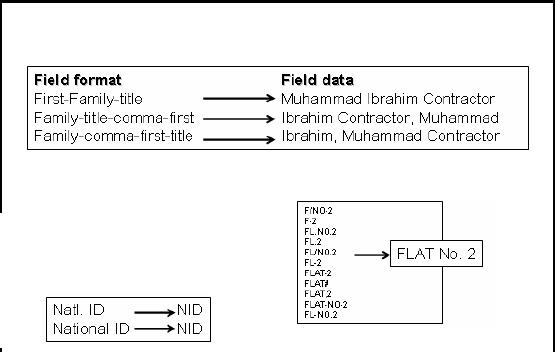
Summarization:
Sometimes you
may find that it is not
feasible to keep data at the
lowest level of
detail in your
data warehouse. It may be
that none of your users
ever need data at the
lowest
granularity
for analysis or querying. F r example,
for a grocery chain, sales
data at the lowest
o
level of detail
for every transaction at the
checkout may not be needed.
Storing sales by product
by store by
day in the data warehouse
may be quite adequate. So, in
this case, the
data
transformati n
function includes summarization of
daily sales by product and
by store.
o
Enrichment:
This
task is the rearrangement
and simplification of individual
fields to make them
more useful
for the data warehouse
environment. You may use one
or more fields from the
same
input record to
create a better view of the
data for the data
warehouse. This principle is
extended
when one or
more fields originate from
multiple records, resulting in a single
field for the
data
warehouse.
To better
understand lets discuss con
version and enrichment with
examples.
Data
Transformation Basic Tasks:
Conversion
� Convert
common data elements into a
consistent form i.e. name
and address.
Table -16.1
(a)
�
Translation of dissimilar
codes into a standard
code.
Table-16.1(b)
Table-16.1:
Data Transformation Basic Tasks:
Conversion
As discussed
earlier, conversion is performed to standardize data
by converting data
from
multiple
heterogeneous sources into a single
consistent form making it usable
and
understandable.
For example, a data field
containing name and job
title can be represented in
a
number of
ways in different source
systems as shown in Table
16.1(a). Here three
different
formats
have been shown for the
same field. Similarly, Table
16.1(b) shows another
example of
code
standardization of dissimilar code
representations. Here, two different
codes have been
shown
for representing National
Identity which
can be converted to a consistent form
like NID.
Same is
the case for address
representation like house
number and flat number
etc.
124
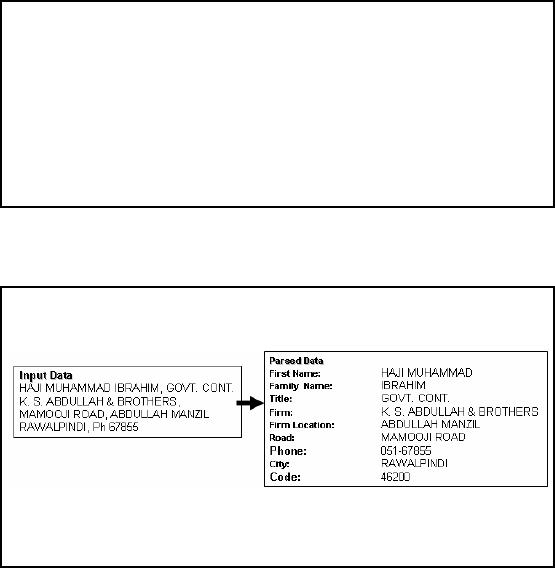
Data
Transformation Basic Tasks:
Conversion
�
Data
representation change
� EBCIDIC to
ASCII
�
Operating System
Change
� Mainframe
(MVS) to UNIX
� UNIX to NT or
XP
�
Data type
change
� Program
(Excel to Access), database
format (FoxPro to
Access).
� Character,
numeric and date
type.
� Fixed and
variable length.
Why differences in
data from different sources?
Three common reasons are
because data at
different
locations may have diffe
rent data representation
codes, different operating
systems and
different
data types.
Data
Transformation Basic Tasks:
Enrichment
�
Data
elements are mapped from
source tables and files to
destination fact and dimension
tables.
(a)
(b)
� Default
values are used in the
absence of source
data.
�
Fields
are added for unique keys
and time elements.
Figure-16.2:
Data Transformation by
Enrichment
Enrichment is
one of the basic tasks of
data transformation as shown in Figure
16.2. Figure -16(a)
shows
input data that does not
have any associated
information that links semantics
with the
given
data i.e. what means what?
Hover after enrichment the
contents of the input data
are
assigned to
the corresponding attributes or fields.
Recognize that this could be a
very difficult
task if
the order of the contents of
the input varies across
the records. Assuming that is not
the
case,
the assignment can be very
straightforward. There are
certain values that are not
given in the
input but
are implied, such as the
postal code, or the phone
code etc. In such a case
default values
are
used based on the input
data using standard default
values. Other information added could
be
unique keys
for identification of data,
such that the keys
are independent of the
business rules,
also
the data could be time stamped to
ascertain its
"freshness".
125

Significance
of Data Loading
Strategies
�
Need to
look at:
� Data
freshness
� System
performance
� Data
volatility
�
Data
Freshness
� Very
fresh low update
efficiency
� Historical
data, high update
efficiency
� Always
trade-offs in the light of
goals
�
System
performance
� Availability
of staging table
space
� Impact on query
workload
�
Data
Volat ility
� Ratio of
new to historical data
� High
percentages of data change
(batch update)
Once
data has been transformed,
the loading
operation is
performed. There are different
loading
strategies
and choosing the one
depends on data freshness
and performan ce. We also
need to look
into
data volatility, in other
words, how much data is
changed within the window of
the refresh.
So in general if
real time or near real-time availability
of data is required, meaning low
update
efficiency,
because if want the datato
be very fresh, then I would
not allow accumulation of
lot of
data,
because it means waiting a
long time before data is
inserted. Whereas, if I want
the
maximum update
efficiency i.e. highest
performance, then batch
processing would be required.
Thus as always
there is a tradeoff between performance
and data freshness and you
need to look
at the
goals and objectives of your
data warehouse, how you
follow them and how
important
these
characteristics are. So again
there is no one right or
wrong answer, depends on
what are the
goals of
the data warehouse, and
then you design appropriate to those
goals.
The
data loading strategy will
also depend on the data
storage requirements. Depending
upon
which
strategy you use, some
require more data storage
than others, staging tables
etc. You want
to look at
the impact on query workloads, so when
loading the data, at the
same time these
queries
are running, what does that
mean? Meaning what is allowable and what is
not allowable.
It is also
important to look at the ratio of
existing to new data? And
that will determine or
help
determine what
the strategy should be for
implementation. So we need to look at
what are the
characteristics
of workloads that I am interested in. So
there are clearly some tradeoffs
here. If we
look at a
loading strategy with a high
percentage of data changes per
data block, this
normally
means I am
doing a batch update. In other words, I
have got a lot of data that
I am inserting into
the
table, and therefore each
data block has a lot of rows
that are changing per data
block.
126

Three
Loading Strategies
�
Once we
have transformed data, there
are three primary loading
strategies:
�
Full
data refresh with BLOCK
INSERT or `block slamming'
into empty table.
�
Incremental data
refresh with BLOCK INSERT or `block
slamming' into
existing
(populated)
tables.
�
Trickle/continuous feed
with constant data collection
and loading using row level
insert
and
update operations.
There
can be a couple of lectures on loading
strategies, but in this course
will limit our selves
to
the
basic concepts only. Once
the data has been
transformed, it is ready to be loaded
into the
DWH,
for this purpose three
loading strategies are prevalent.
When the tables are
populated for
the
first time it is a full data
refresh, depending on the tool or
the environment being used,
this
may be
called as BLOCK INSERT or
"block slamming" i.e. large blocks of
data are loaded,
usually in
the form of batch updates.
As the DWH evolves over
time, there may be no
empty
tables, but
already filled table have to be
updated. For this purpose
DWH has to be
refreshed
incrementally. Depending on
the line of business and
other reporting requirements the
refresh
period
will vary and also
the amount of data to be
loaded. In extreme cases
this may boil down
to
BLOCK
INSERT or "block slamming" into
the main DWH tables. This
will have certain
performance implications
with reference to availability of
data, and the outcome of
the queries
while
the data is being refreshed
and requirement of additional memory
space in the form of
"shadow tables",
but the discussion is beyond
the scope of this course.
The third and final
loading
strategy is
trickle feed. This strategy is more in
the context of active data
warehousing and has a
high
update overhead. Usually the criterion when to load
depends on the time interval
between
uploads or
the amount of data recorded
or their combination.
127
Table of Contents:
- Need of Data Warehousing
- Why a DWH, Warehousing
- The Basic Concept of Data Warehousing
- Classical SDLC and DWH SDLC, CLDS, Online Transaction Processing
- Types of Data Warehouses: Financial, Telecommunication, Insurance, Human Resource
- Normalization: Anomalies, 1NF, 2NF, INSERT, UPDATE, DELETE
- De-Normalization: Balance between Normalization and De-Normalization
- DeNormalization Techniques: Splitting Tables, Horizontal splitting, Vertical Splitting, Pre-Joining Tables, Adding Redundant Columns, Derived Attributes
- Issues of De-Normalization: Storage, Performance, Maintenance, Ease-of-use
- Online Analytical Processing OLAP: DWH and OLAP, OLTP
- OLAP Implementations: MOLAP, ROLAP, HOLAP, DOLAP
- ROLAP: Relational Database, ROLAP cube, Issues
- Dimensional Modeling DM: ER modeling, The Paradox, ER vs. DM,
- Process of Dimensional Modeling: Four Step: Choose Business Process, Grain, Facts, Dimensions
- Issues of Dimensional Modeling: Additive vs Non-Additive facts, Classification of Aggregation Functions
- Extract Transform Load ETL: ETL Cycle, Processing, Data Extraction, Data Transformation
- Issues of ETL: Diversity in source systems and platforms
- Issues of ETL: legacy data, Web scrapping, data quality, ETL vs ELT
- ETL Detail: Data Cleansing: data scrubbing, Dirty Data, Lexical Errors, Irregularities, Integrity Constraint Violation, Duplication
- Data Duplication Elimination and BSN Method: Record linkage, Merge, purge, Entity reconciliation, List washing and data cleansing
- Introduction to Data Quality Management: Intrinsic, Realistic, Orr’s Laws of Data Quality, TQM
- DQM: Quantifying Data Quality: Free-of-error, Completeness, Consistency, Ratios
- Total DQM: TDQM in a DWH, Data Quality Management Process
- Need for Speed: Parallelism: Scalability, Terminology, Parallelization OLTP Vs DSS
- Need for Speed: Hardware Techniques: Data Parallelism Concept
- Conventional Indexing Techniques: Concept, Goals, Dense Index, Sparse Index
- Special Indexing Techniques: Inverted, Bit map, Cluster, Join indexes
- Join Techniques: Nested loop, Sort Merge, Hash based join
- Data mining (DM): Knowledge Discovery in Databases KDD
- Data Mining: CLASSIFICATION, ESTIMATION, PREDICTION, CLUSTERING,
- Data Structures, types of Data Mining, Min-Max Distance, One-way, K-Means Clustering
- DWH Lifecycle: Data-Driven, Goal-Driven, User-Driven Methodologies
- DWH Implementation: Goal Driven Approach
- DWH Implementation: Goal Driven Approach
- DWH Life Cycle: Pitfalls, Mistakes, Tips
- Course Project
- Contents of Project Reports
- Case Study: Agri-Data Warehouse
- Web Warehousing: Drawbacks of traditional web sear ches, web search, Web traffic record: Log files
- Web Warehousing: Issues, Time-contiguous Log Entries, Transient Cookies, SSL, session ID Ping-pong, Persistent Cookies
- Data Transfer Service (DTS)
- Lab Data Set: Multi -Campus University
- Extracting Data Using Wizard
- Data Profiling